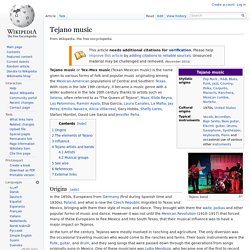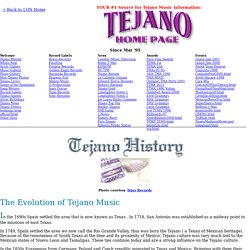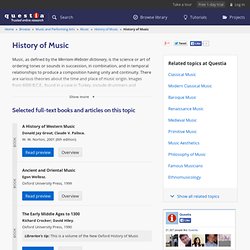

Significant Albums, Artists and Songs. Tex-Mex - artists examples. Sam The Sham & The Pharaohs Woolly Bully. Tex-mex music & examples. Selena - I could fall in love. Los Lobos – La Bamba – Listen and discover music at Last. Freddy Fender: Vaya Con Dios. Tejano music. Tejano music or Tex-Mex music (Texan-Mexican music) is the name given to various forms of folk and popular music originating among the Mexican-American populations of Central and Southern Texas.

With roots in the late 19th century, it became a music genre with a wider audience in the late 20th century thanks to artists such as Selena, often referred to as "The Queen of Tejano", Mazz, Elida Reyna, Los Palominos, Ramón Ayala, Elsa García, Laura Canales, La Mafia, Jay Perez, Emilio Navaira, Alicia Villarreal, Gary Hobbs, Shelly Lares, Stefani Montiel, David Lee Garza and Jennifer Peña. Origins[edit] Tejano Music History. Photo courtesy Tejas Records The Evolution of Tejano Music In the 1690s Spain settled the area that is now known as Texas .

In 1718, San Antonio was established as a midway point to the missions of east Texas. In 1749, Spain settled the area we now call the Rio Grande Valley, thus was born the Tejano ( a Texan of Mexican heritage). Because of the remoteness of South Texas at the time and its proximity of Mexico, Tejano culture was very much tied to the Mexican states of Nuevo Leon and Tamalipas.
In the 1850s Europeans from Germany, Poland and Czech republic migrated to Texas and Mexico. It was a rough life, but one of pride. With the accordion, drum and the bajo sexto, a 12 string bass guitar from Spain, Tejanos now had a sound they could begin to call their own. In the 1950s, Isidiro Lopez further revolutionize the Tejano sound by taking out theflowery Spanish that Valerio used and used Tex-Mex instead. Will Tejano change? List of books and articles about History of Music. Music, as defined by the Merriam-Webster dictionary, is the science or art of ordering tones or sounds in succession, in combination, and in temporal relationships to produce a composition having unity and continuity.

There are various theories about the time and place of music origin. Images from 6000 B.C.E., found in a cave in Turkey, include drummers and dancers. Music was mentioned in clay tablets which date from ancient Mesopotamia, where lyres, pipes, drums, bells and harps were used to make music. Western music is influenced by Ancient Greek music, primarily ancient Greek theoretical writings. What is Tejano Music? Tejano music is from the Mexican origin population of Texas and is sung in Spanish.

What is Tejano music? Which instruments are used? Is Cumbia music the same as Tejano? Tejano music (Texan music) is the name given to various forms of folk and popular music originating among the Hispanic populations of Central and Southern Texas.

In recent years artists such as La Mafia, Selena Quintanilla, Emilio Navaira, and Selena's brother A.B. Worldwide - the largest accordion internet site with weekly news from around the world about festivals, competitions seminars, artists, concerts, masterclasses, events, CD reviews, videos, celebrity interviews, information about accordion producers and th. Believe it or not, it all began in the middle of the nineteenth century in Germany.

Yes, the diatonic accordion, the main instrument of Tex-Mex music, was created by Friedrich Buschman, whose fellow country-men emigrated to the state of Texas, around 1890, to work the fields, and the construction of railroad lines in Northern Mexico. During lunch breaks, the recent arrivals played waltzes and polkas, while Mexican-Americans, better know as Chicanos, listened to the fantastic resonance. Little by little, locals began making the small-buttoned instrument their own, and in time, the mazurkas became «corridos» of love and despite, and began to be danced and tapped, real close together, from the Valley of Texas, to Nuevo Laredo. In 1935, Mr. Santiago Jiménez was the first to make recordings of polkas, northern «corridos», «rancheras», and «guapangos» in Spanish. As a child, Leonardo «Flaco» Jiménez used to go with his father to their «tocadas» (presentations).